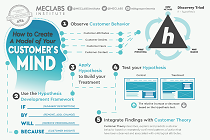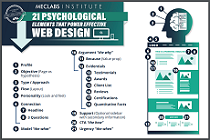
|
SUMMARY:
In this article, we bring you three case studies that present distinct challenges and solutions within the online marketing and SEO domain to ensure a well-rounded SEO approach:
Read on for three SEO strategies for online growth. |
Get the power of 10,000 marketing experiments working for you. Play with MECLABS AI by signing up for a free trial at MECLABS.com/AI (MECLABS is the parent organization of MarketingSherpa).
Hack Chinese is an EdTech SaaS platform that helps students learn Mandarin words. Facing stagnant organic traffic, Hack Chinese pivoted from ads to a content-driven strategy with remarkable results.
Hack Chinese generated most of its web traffic via paid search ads. The website got 10,000 organic monthly search impressions and organic traffic made up less than 10% of overall traffic. The e-learning provider primarily received organic traffic through searches for its brand name.
But the team had never focused on SEO. The website had a blog with only one article – ‘6 questions to ask when choosing a Chinese language school’ – which lacked search optimization.
Creative Sample #1: E-learning provider’s only blog article (before)

Hack Chinese had very limited resources which meant they could not massively recruit influencers or increase paid search budgets. They zeroed in on content marketing for growth.
Targeting generic and ultra-common search queries like ‘learn Chinese’ would lead to competing with thousands of websites globally. The market for Mandarin learning is saturated, with bloggers and businesses vying for top organic rankings. This would be a daunting task for a start-up like Hack Chinese.
The team centered their search marketing efforts on the bottom of the funnel. They went after high-intent search queries – these are the keywords people use when actively looking for a solution to their existing problem.
They delved deep into their target customer's needs to identify high-intent keywords. What are they looking for? In this case, Hack Chinese addresses the need to learn Chinese vocabulary, so they prioritized keywords like ‘learn Chinese vocabulary’ and ‘tools to learn Chinese vocabulary.’
Niche keywords usually have lower keyword difficulty unlike broad generic terms, which means it’s easier to hit top-ranking positions for them.
However, the team wanted to ensure that the keywords weren’t so niche that only a few people were searching for them.
To ensure the search queries they selected had a high potential for bringing lots of traffic, the team estimated how many people were actually looking them up. “We used tools like Ahrefs and SE Ranking to obtain reliable search volume metrics,” said Yuliya Gorenko, Strategic Advisor, Mischka Agency (Hack Chinese’s inbound marketing agency).
The team started to work on blog articles that explicitly covered their target search terms. They knew the audience would easily spot fluff content and generic, keyword-stuffed articles, which could lead to high bounce rates negatively impacting search rankings.
That’s why they had Daniel Nalesnik, the founder of Hack Chinese, heavily involved in the topic generation process.
Between September 5, 2020 and May 28, 2022, they wrote 39 blog posts, like ‘Proven techniques to learn Chinese vocabulary.’
Creative Sample #2: E-learning provider’s blog posts (after)

To offer more value to the reader, they added practical vocabulary to all articles they created. This way, instead of just learning about the topic, the reader could get access to the relevant words.
For example, in ‘Ordering Food In Chinese: A Step-by-step Guide & Useful Vocabulary,’ Mandarin learners can grasp basic cultural norms of eating out in China and immediately practice the handy terms provided in the article. Using Hack Chinese as a vocabulary memorization tool becomes a natural next step.
Over the first four months of implementing this strategy, the language learning provider achieved the following results:
It’s been over 3 years since this campaign started and the brand is seeing consistent organic traffic.
“I learned that successful marketing goes beyond numbers; it's about crafting meaningful narratives that resonate with customers on a personal level”, says Daniel Nalesnik, Founder, Hack Chinese.
Citing the simple content marketing strategy used in this campaign, Gorenko said, “Small business founders can get easily overwhelmed by the avalanche of ‘tips and tricks’ on how to grow organic traffic. Yet, search marketing does not have to be complicated.”
Tacuna Systems is an online B2B retailer of scale components. Its customers need weighing as part of an industrial process such as food packaging (making sure product weights are consistent) or for testing.
The team was looking to improve SEO sitewide. They did just about everything they could think of from comprehensive keyword strategy to internal linking, fixing dead links and the like. Yet, the site was still not ranking.
“Incidentally, all of us at Tacuna Systems are engineers – I kind of learned marketing on the fly with a lot of tutorials on the tools I use so everything I have done has been trial and error,” said Maria Pontones-Bonenfant, Digital Marketing Manager, Tacuna Systems.
In 2022, the industrial equipment supplier migrated the whole site to a faster platform, dramatically decreasing load time metrics.
On the previous platform, the website loaded in around 1.5 seconds on average. “The platform the website used to run on was Divi. We now use GeneratePress, and for example, the main shop page now loads at about 750ms,” Pontones-Bonenfant said.
“Also, we use Cloudflare Pro and WP Rocket which really help a ton as well,” said Chris Lange, Chief Engineer and Owner, Tacuna Systems.
The website was getting a performance score from Google Page Speed Insights in the 30 to 40 range and is now getting a 97 (more on that below).
The team figured improved page speed would also affect search rankings, but they were surprised at how big of an effect it had.
Rankings shot up soon after the migration – 67% of targeted keywords moved to the first page and 50% got into a top-three position. The rankings have remained high.
Creative Sample #3 – Wincher chart showing jump in search rankings (blue signifies ranking in position 1, green in positions 4 through 10, orange in a position higher than 100)

“Google Page Speed Insights is all that matters to Google. And, mobile-first is Google's current approach. Forget the desktop scores – from what I can tell, they mean nothing because all desktop scores are generally really high,” Lange said. “Google collects data from mobile Chrome browsers on Android (not iOS) to derive the ‘real’ score for your website (where it says ‘discover what your real users are experiencing’ [in the tool]) – which doesn't necessarily represent the score when you run their tool.”
As an example, he provided screenshots of 97 (out of 100) under ‘diagnose performance issues’ yet a Core Web Vitals assessment of ‘failed’ under ‘discover what your real users are experiencing.’
“From what I can tell, the ‘real’ score heavily depends on the users’ phone speed, connection speed, etc. A lot of things we cannot control – so the point is to make the website as light as possible so someone in India on Android 7 can still have a decently fast load time,” Lange said.
This doesn’t mean that a fast page that doesn’t have relevant, quality content will still rank high. But it does suggest if your otherwise optimized pages aren’t ranking, you should take a good, hard look at how quickly they load.
“The lesson is that no matter how good your SEO practices are, page speed reigns supreme in Google's algorithms and slow pages will not rank, no matter what!” Pontones-Bonenfant said. “Great marketing can be thwarted by basic tech.”
SEO doesn’t really stop at SEO. You have to consider LPO as well. Because a lot of traffic with few conversions is not going to help you meet your marketing goals.
In this next example, the new landing page is far from perfect. And I hope that is encouraging to you. It shows that you don’t need a perfect page to improve results with a better strategy. Read on to discover the simple webpage changes that led to a 19.2% increase in sales.
Edinburgh First Aid Courses is part of Skills Training Group, which provides training on a number of topics in the UK.
Since they offer a better price than the competition, the team pushed pricing in its original landing pages.
The webpage layout had a lot of empty spaces because the team wanted visitors to focus on the affordable price they were offering. They also made the price tag stand out from the other text by making it larger than the other text.
Creative Sample #4: Previous landing page, with call outs describing its strategy

Their sole focus on price led to a bounce rate of 48%. The team knew they had to offer more.
“Since we only highlighted our price which was a single value point, potential customers would scroll and bounce back to something else. We needed to highlight more value points to the customers,” said Mark McShane, Managing Director, Edinburgh First Aid Courses.
So the team decided to make changes to the page and include relevant content that would add more value to the customers.
The team greatly reduced the text size of the price and included it in a box in the top left of the page between other info about the course – a box that said ‘Full Time’ and a box that said ‘3 Day(s).’
They added more content to the page and didn’t want the price to overshadow it. They added four new elements in the empty space of the webpage in an attempt to communicate value to customers, and not just focus on price.
First, they reduced anxiety by guaranteeing an affordable price compared to competitors. They consider this guarantee to be a unique selling point. “After doing market research, we found that all the competitors in the areas where we provide our services were offering the same services at a higher price. That's why we decided to offer a price match guarantee against competitors and none of them were offering a price match guarantee,” McShane said.
Then, they explained how the course is offered and included a potential upsell. They wanted to transparently show that certain customers – those looking for on-site courses – would be charged more.
Just below that, in the third point, they highlighted the credibility and authenticity of the service by explaining the people who complete the course get a certification from an independent organization.
In the bottom-left empty space, they added a brief description of the service to provide some value messaging about what customers receive from the course.
Additionally, the first letter of each word is capitalized. “We tested the webpage with both normal case text and ‘Initial Case’ text. The version with ‘Initial Case’ text performed slightly better that's why we kept it like that,” McShane said.
Creative Sample #5: New landing page, with call outs describing its strategy

Following these alterations, the bounce rate on the page dropped to 35.9%. After the positive results, the team implemented these changes on the pages for all of their courses and saw a 19.2% sales increase.
While pricing is crucial, this example shows that customers value transparency, credibility, and a clear understanding of what they're getting.
Evolving Engagement: How modern and traditional strategies boosted conversions
Get Better Business Results With a Skillfully Applied Customer-first Marketing Strategy

The customer-first approach of MarketingSherpa’s agency services can help you build the most effective strategy to serve customers and improve results, and then implement it across every customer touchpoint.
Get More Info >MECLABS AI

Get headlines, value prop, competitive analysis, and more.
Use the AI for FREE (for now) >Marketer Vs Machine

Marketer Vs Machine: We need to train the marketer to train the machine.
Watch Now >Live, Interactive Event

Join Flint McGlaughlin for Design Your Offer on May 22nd at 1 pm ET. You’ll learn proven strategies that drive real business results.
Get Your Scholarship >Free Marketing Course

Become a Marketer-Philosopher: Create and optimize high-converting webpages (with this free online marketing course)
See Course >Project and Ideas Pitch Template

A free template to help you win approval for your proposed projects and campaigns
Get the Template >Six Quick CTA checklists

These CTA checklists are specifically designed for your team — something practical to hold up against your CTAs to help the time-pressed marketer quickly consider the customer psychology of your “asks” and how you can improve them.
Get the Checklists >Infographic: How to Create a Model of Your Customer’s Mind

You need a repeatable methodology focused on building your organization’s customer wisdom throughout your campaigns and websites. This infographic can get you started.
Get the Infographic >Infographic: 21 Psychological Elements that Power Effective Web Design

To build an effective page from scratch, you need to begin with the psychology of your customer. This infographic can get you started.
Get the Infographic >Receive the latest case studies and data on email, lead gen, and social media along with MarketingSherpa updates and promotions.